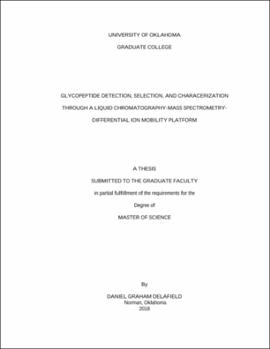| dc.contributor.advisor | Wu, Si | |
| dc.contributor.author | Delafield, Daniel | |
| dc.date.accessioned | 2018-05-08T14:19:34Z | |
| dc.date.available | 2018-05-08T14:19:34Z | |
| dc.date.issued | 2018-04-26 | |
| dc.identifier.uri | https://hdl.handle.net/11244/299797 | |
| dc.description.abstract | The cellular functions necessary to sustain life are, in large part, mediated by the collection of translated proteins unique to each organism, referred to as the proteome. Due to the broad and ever-growing number of connections drawn between the proteome and biologically significant occurrences, proteomics has established itself as a critical field of research. Though the vastness of the proteome may be understood when assuming a single product for every translated gene, the complexity grows exponentially when considering the process of post-translational modification inherent for each protein and organism. As post-translational modifications are noted to be crucial in understanding the basic and altered functional states of all proteins, a large emphasis is placed on their identification and characterization. And though all post-translational modifications may be considered intricate, none is more so than glycosylation. | en_US |
| dc.description.abstract | Glycosylation stands preeminent in diversity and functionality when compared to other post-translational modifications. Owing to the fact that such modifications can exist in multiple structures, may incorporate several unique monosaccharide units, and are highly dependent on the enzymatic processes by which they are constructed, glycosylation modifications require careful consideration when one attempts to perform analysis and characterization of any glycoprotein conjugate. Knowing this, the following work should serve to provide context as to the elaborate nature of glycobiology, discussion of possible proteomic workflows useful for glycoprotein analysis, and understanding of gas-phase separation techniques. Such comprehensions are necessary prior to detailing the culminating work where glycopeptide features were characterized through a novel, liquid chromatography-mass spectrometry-differential ion mobility platform. | |
| dc.language | en | en_US |
| dc.subject | Proteomics | en_US |
| dc.subject | Mass Spectrometry | en_US |
| dc.subject | Glycobiology | en_US |
| dc.subject | Differential Ion Mobility | en_US |
| dc.subject | Chemistry, Analytical. | en_US |
| dc.title | GLYCOPEPTIDE DETECTION, SELECTION, AND CHARACERIZATION THROUGH A LIQUID CHROMATOGRAPHY-MASS SPECTROMETRY-DIFFERENTIAL ION MOBILITY PLATFORM | en_US |
| dc.contributor.committeeMember | Bourne, Christina | |
| dc.contributor.committeeMember | Liu, Shaorong | |
| dc.date.manuscript | 2018-04-30 | |
| dc.thesis.degree | Master of Science | en_US |
| ou.group | College of Arts and Sciences::Department of Chemistry and Biochemistry | en_US |
| shareok.orcid | 0000-0003-2989-9833 | en_US |
